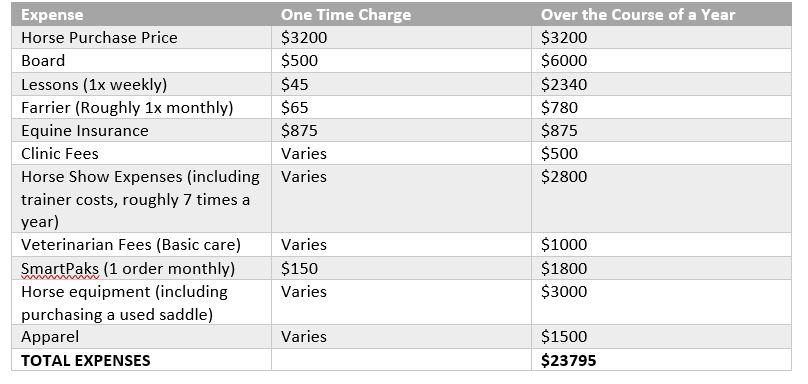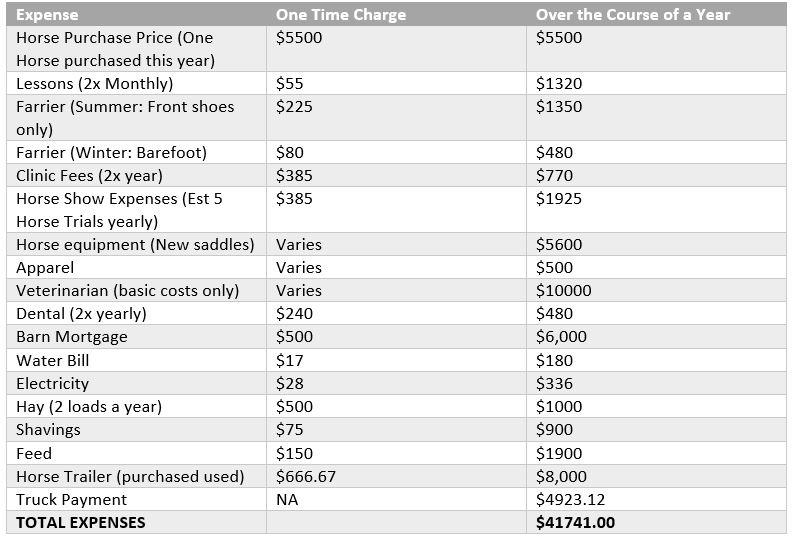
The Debt Free Equestrian: The Costs of Owning a Horse
As most horse owners have realized, the actual purchase price of a horse isn’t the expensive part — it’s the day to day and month to month expenses that add up. Meagan DeLisle looks at three real-life examples to illustrate.
Recently my dad challenged me to consider how much I have spent on my horse in one year in another desperate attempt to encourage me to find another less-expensive hobby. What he didn’t know was that I had already calculated these expenses when we were still in the middle of our debt snowball as I tried to decide if I truly could afford a horse while trying to become debt free. And let me tell you — it can be pretty scary.
We all know that horses are not an inexpensive endeavor. Every time you turn around there are additional costs creeping around the corner ready to pop up and bite you in the wallet. So many people rush into horse ownership without considering ALL of the expenses associated with horse ownership and unfortunately it can turn what is supposed to be one of the happiest moments of your life into a painful memory.
In an attempt to prepare first-time horse owners for what they might be in for, three generous horse owners decided to share a typical year of expenses related to horse ownership. Please note, these expenses will vary depending on your location. This is just a baseline for you to consider — the costs of owning a horse in your area and competing in a different discipline could be more or less.
Horse Owner A:
Boards one horse. Competes on the local hunter/jumper circuit.
 Horse Owner A purchased their horse this year, so they had that additional investment to factor into their yearly costs. They board at a full care facility, but their board does not include training for their horse. Horse Owner A likes to attend many different clinics and schooling shows throughout the year, but has not made the transition to the rated circuit yet
Horse Owner A purchased their horse this year, so they had that additional investment to factor into their yearly costs. They board at a full care facility, but their board does not include training for their horse. Horse Owner A likes to attend many different clinics and schooling shows throughout the year, but has not made the transition to the rated circuit yet
Horse Owner B:
Keeps two horses at home. Competitive eventer.
Horse Owner B lives the dream of keeping their horses at home, but as you can see, additional expenses can add up. When you are not boarding, you have to factor in costs of feed, hay, utilities, facility care, and the cost of the hours you spend doing these tasks on your own. Owning more than one horse also adds to Horse Owner B’s daily expenses — double the fun, but double the trouble!
Horse Owner C:
Boards one horse at a training facility. Competes on the AQHA Circuit in western pleasure.
Horse Owner C competes actively on the breed circuit in western pleasure and has had a great deal of success, but has had to find creative ways to make the budget work. As you can see, training board is almost double what basic full care would be for Horse Owner A.
The Rundown
While these numbers can be shocking, these are three very different examples. There are going to be cost-saving opportunities along the road of horse ownership. For example, Horse Owner C makes extra income by banding horses when they travel to shows and brings in almost $5000 a year in doing so! Horse Owner B runs their own business and can trade some services for discounts in the industry. Horse Owner A has found a way to supplement their income by freelancing in the industry and by doing most of their care at shows on their own.

Many horse owners are able to supplement their income and balance out some of their show expenses by grooming for others or just taking over their own grooming. John Shortland/Wikimedia/CC
Apparel and tack are the two demons that people often forget to include in their budget. Horse Owner A was able to purchase a used saddle for roughly $1200 this past year and has invested in a few other key pieces over the year, but has had to push pause on a few things they had hoped to buy. Horse Owner C has invested in quality items throughout their years of showing and has found that many of the western pleasure items retain their value for years, allowing her to trade up and retain her original investment when the time comes. Several of Horse Owner C’s show pieces have been in their possession for over 10 years and still hold their value. Over the years, Horse Owner C has spent about $30,900 in tack and show apparel.
Horse Owner B lives the dream and keeps their horses at home, but you can see the costs add up quickly. To save some money, Horse Owner B opted to keep their horses barefoot in the winter as they don’t tend to compete as much. Purchasing a trailer, investing in a property, and the cost of your time for labor can add up when opting to keep your horse at home, so always consider those investments as well if you are dreaming of having your own facility one day.

Keeping your horses at home is a dream many equestrians have, but you should be prepared for the additional costs that come along with that dream. bagsgroove/FlickR/CC
For the highly competitive, these numbers can double or triple quickly. However, if you intend on just pleasure riding you can deduct several of the expenses factored into these budgets. Planning out your journey into horse ownership is imperative; jumping in blind can leave you in a rut and turn that dream of yours into a nightmare. Sort out your personal budget first, then with the remainder plan on how you can arrange your equine budget to make this dream come true. Save up, have an emergency fund, and pay for everything in cash to avoid building up additional debt. If you have the discipline to lay out your budget appropriately and save up large amounts of money for their pricier purchases before you leap into horse ownership, you will find yourself more at peace when in the saddle.
Go riding!









Leave a Comment